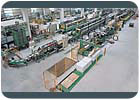
The Margraf Group of Chiampo, Vicenza, Italy, invested in a new state-of-the-art plant for tile production from Pedrini in March of this year.
Already one of the leading stone producers in Italy, the Margraf Group of Chiampo, Vicenza, Italy, recently invested in a new state-of-the-art plant for tile production. This expansion comes only two years after the company invested in a high-tech line for resin-treated slab production.
The equipment for the new tile plant is from Pedrini of Italy, and it was installed in March of this year. It is capable of producing tiles measuring 1 cm thick (roughly 3/8 inch) with widths ranging from 300 to 610 mm (approximately 12 to 24 inches). When processing 300-mm-wide tiles, the line operates at a speed of 12 meters (39.4 feet) per minute, with an overall capacity close to 200 square meters (2,150 square feet) per hour. During an 8-hour shift, the plant is capable of producing 1,500 square meters (over 16,000 square feet) of finished tiles.
The tile line has a length of about 150 meters, and it can process all marble and limestone varieties available in the marketplace today.

During an 8-hour shift, the plant is capable of producing 1,500 square meters (over 16,000 square feet) of finished tiles.
Mirroring ceramic production
The overall concept of Margraf's new tile line was inspired by the typical processes of the ceramic tile production. During the operation, semi-finished pieces with a thickness of about 11 mm are produced on a splitting machine, and then gauged and pre-polished by the first Pedrini unit to a thickness of 10.2 mm.The finishing line is then fed the single-sized semi-finished pieces, which are carefully positioned on a pallet and maneuvered by automatic systems. Because the line processes pieces that have already been calibrated for thickness and feature a width very close to the rated dimension, it operates at an optimum speed.
To reach this high operating speed of 12 meters per minute, the unit removes material at a rate of up to 3,000,000 cu.mm per minute. And even though great power is thus applied on each semi-finished piece, Pedrini reports that the line operates without the risk of breakage due to the use of rollers with a high diamond concentration that work sloped to the movement direction, thus distributing the removal effort on a longer section of the semi-finished piece.
Moreover, the width being processed can be quickly changed by modifying the roller sloping. This offers not only optimal speed, but a high level of flexibility without reducing overall performance.
If resin treatment is necessary on the stone tiles, the resin is automatically distributed evenly on the pre-polished surface. A high-capacity oven then solidifies the resin.
After this step, the first grinding and chamfering step takes place on two sides of the workpiece (the sides running parallel to the movement of the line). Also, any possible resin residue is removed from the sides.
The workpiece then moves on to the cross-cutting unit, which cuts the stone to the desired length. When processing 330-mm-long pieces, the machine runs at a rate of 36 pieces per minute. A squarer aligns the semi-finished pieces orthogonal to the disc-cutting direction, while an individual fast-locking system prevents them from moving during the cross cut. The cross cutting/squaring machine cuts 20 semi-finished pieces during each pass in a time of 33 seconds, maintaining an overall operating speed of 12 meters per minute.
The last unit on the line chamfers the two cross-cut sides. Once the tiles have completed the production cycle, they are transferred to the individual electronic control station to have their dimensions and orthogonality checked, and to ensure that the required quality level has been reached.